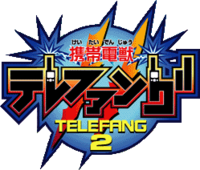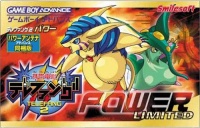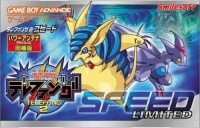Telefang 2: Difference between revisions
No edit summary |
(Added characters section.) |
||
| Line 1: | Line 1: | ||
{{Infobox game | {{Infobox game | ||
| name = Keitai Denjuu Telefang 2 | | name=Keitai Denjuu Telefang 2 | ||
| japname = 携帯電獣 テレファング 2 | | japname=携帯電獣 テレファング 2 | ||
| romaji = Keitai Denjuu Terefangu 2 | | romaji = Keitai Denjuu Terefangu 2 | ||
| series = Telefang | | series = Telefang | ||
| Line 20: | Line 20: | ||
With only one antenna tree in existence, that tree was the only entrance left from the human's world to the Denjuu's world. The player, naturally, must stop him before he is stuck in the world forever. <ref>http://www.rocketcompany.co.jp/t2/t2_003.html</ref> | With only one antenna tree in existence, that tree was the only entrance left from the human's world to the Denjuu's world. The player, naturally, must stop him before he is stuck in the world forever. <ref>http://www.rocketcompany.co.jp/t2/t2_003.html</ref> | ||
==Characters== | |||
===Humans=== | |||
{{main|List of people}} | |||
* '''Kyou''' {{lang|jap=キョウ}} | |||
* '''Midori''' {{lang|jap=ミドリ}} | |||
* '''Yuu'''{{lang|jap=ユウ}} | |||
* '''Otome''' {{lang|jap=オトメ}} | |||
* '''Matsukiyo''' {{lang|jap=マツキヨ}} | |||
===Denjuu=== | |||
* '''[[Rex (Basic)|Rex]]''' {{lang|jap=レックス}} | |||
* '''[[Doon (Basic)|Doon]]''' {{lang|jap=ドーン}} | |||
* '''[[Gyuun (Basic)|Gyuun]]''' {{lang|jap=ギューン}} | |||
* '''[[Chakor (Basic)|Chakor]]'''{{lang|jap=チャコル}} | |||
* '''[[Diablos (Basic)|Diablos]]''' {{lang|jap=ディアボロス}} | |||
==Changes from Telefang 1== | ==Changes from Telefang 1== | ||
Revision as of 15:56, 20 January 2012
| Keitai Denjuu Telefang 2 | |
  
| |
| Series | Keitai Denjuu Telefang |
|---|---|
| Versions | Power and Speed |
| Developer(s) | Smilesoft |
| Publisher(s) | Natsume
|
| Genre | Console role-playing game |
| Platform | Game Boy Advance |
Keitai Denjuu Telefang 2 is the sequel to the first Telefang game for the Game Boy Advance. Taking place in a different part of the Denjuu world from the first one, this game shares some qualities with Telefang 1. The battle system is similar, as is the gathering-phone-numbers system, but a good deal of things are quite different from the original. Limited-edition versions of the game included a peripheral called the Power Antenna.
Plot
The game follows a blue-haired protagonist (named by the player but original called Kyou) as he journeys on his quest to become a T-Fanger. Along the way, he encounters Diablos, who is not content with humans entering the Denjuu universe and so is killing off the Antenna trees, thereby cutting off access to the human world.
With only one antenna tree in existence, that tree was the only entrance left from the human's world to the Denjuu's world. The player, naturally, must stop him before he is stuck in the world forever. [1]
Characters
Humans
- Main article: List of people
- Kyou ()
- Midori ()
- Yuu()
- Otome ()
- Matsukiyo ()
Denjuu
Changes from Telefang 1
- Main article: Differences between Telefang 1 and Telefang 2
There have been significant differences in the two games, Telefang 1 and 2.
- The sprites were redrawn
- The background music was changed
- New Denjuu were introduced
- Move types were introduced, and a Denjuu which has a type disadvantage would not necessarily lose if it has good moves.
- In Telefang 1, the starter partner would be different in both versions (Crypto and Fungus), while in Telefang 2 it would be Rex for both versions.
- The new Denjuu mod evolve differently. Unlike the old Denjuu, their habitat type would change as they mod evolve. For mod evolved Denjuu that return in Telefang 2, their types have changed to reflect this pattern.
- Some Denjuu evolve differently, with many evolution chains drastically shortened or even completely removed.
- In battle, each Denjuu has a friend that is specific to a Denjuu, which randomly appears and attacks the opponent.
- In Telefang 1, wild Denjuu cannot be seen before battling them (similar to Pokémon), except at some specific areas. In Telefang 2, wild Denjuu can be seen in the overworld, and coming close to one will cause a battle to start (similar to Zelda II or Super Mario RPG).
Release
This game was only ever released in Japanese; however, there are hackers who have been able to edit the hexadecimal values in the ROM images to release an English patch.